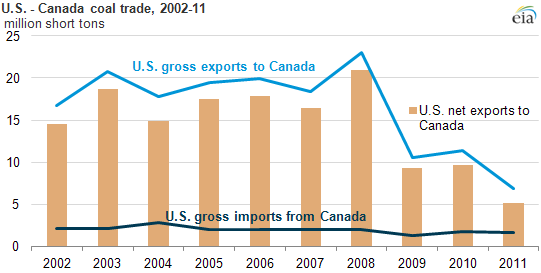
Canada Week: Canada is a declining market for U.S. coal

Note: U.S. net exports to Canada equals the difference between U.S. gross exports to Canada and U.S. gross imports from Canada.
Exports of U.S. coal to Canada have declined in recent years as Canada has reduced its coal-fired electric generation.
U.S. coal exports to Canada totaled 3.2 million short tons and represented roughly 5% of the 66.2 million short tons of total U.S. coal exports during the first half of 2012, according to EIA's Quarterly Coal Report. Further, coal exports to Canada as a share of U.S. total coal exports are expected to reach a record low later this year. The share of U.S. coal exports destined for Canada averaged 41% between 2002 and 2006. This percentage has declined annually since 2007, according to annual U.S. coal exports data.
The decline is largely the result of Canadian initiatives to reduce coal-fired electric generation. In an effort to reduce greenhouse gases, Canadian federal and provincial governments have announced policies to move away from coal-fired generation. Beginning July 1, 2015, the Canadian federal government plans to enforce a strict performance standard for all coal-fired units. The addition of the new regulations will likely encourage utilities to retire aged coal-fired generators and shift to lower- or non-emitting fuels (i.e., natural gas and renewable energy).
Steam coal demand in Canada, which accounted for approximately 88% of total coal consumption in 2011, is primarily used for power generation. In 2011, according to the latest data available, about 16 % of Canada's electricity was generated using coal, down from 18% in 2010. A shift to lower- or non-emitting fuels may cause further decreases in coal's share of total generation.
Tags: Canada, coal, consumption/demand, exports/imports, international